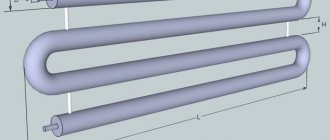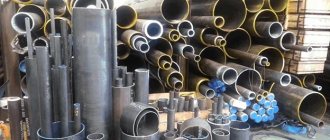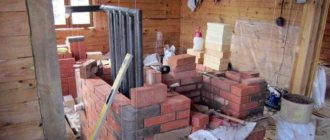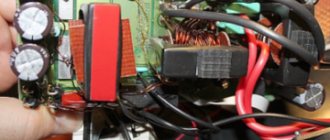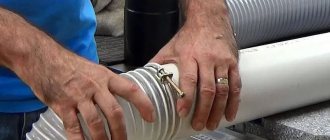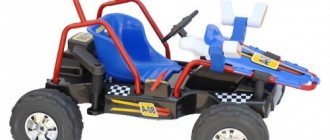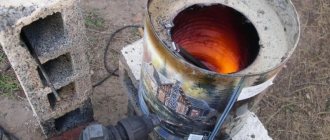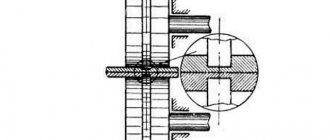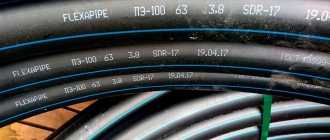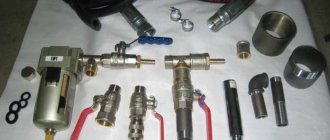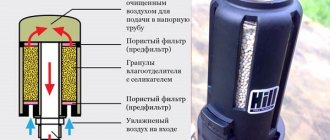In private houses there are always several utility or technical rooms, where the requirements for the interior are low. But you still need to heat them, and in order not to spend money on buying modern radiators, you can install a steel register welded from pipes there. And, although everyone has seen such simple heating devices with their own eyes, not everyone knows their structure. This material is to help those homeowners who want to independently manufacture, install and connect heating registers to their system.
Serpentine registers (S-shaped)
Such registers have become quite popular. The design of these devices is quite simple: there are several sections that are connected by arcs, the diameter of which is close to the sectional ones. Due to this, the hydraulic pressure inside the device is significantly reduced. As a result, the register becomes a single unit, the entire surface of which is working, which significantly increases the efficiency of such devices.
Such heating registers made of smooth pipes usually contain a large amount of carbon. In addition, registers made of other materials can be found on the market: cast iron, alloy or stainless steel.
Types of registers to install
The most commonly used products are cast iron, steel and aluminum. The most common are aluminum. Their advantages are the following:
- resistant to corrosion;
- have minimal weight;
- long period of use;
- there are no connections or joints from welding;
- high heat transfer.
Monolithic casting is used in the manufacture of aluminum registers. Such products are most often installed in residential and office premises. If you need heating in production, it is better to install registers made of steel or cast iron, as they are more durable. Heating systems can be either stationary, in which the coolant is heated using a boiler, or mobile. Such registers have special protection against accidental electric shock. Steel heating registers are not characterized by high heat transfer, but they benefit significantly due to their budget cost, ease of processing and large selection of sizes.
Stainless steel registers are also used, but they have low heat transfer, so their manufacture requires a lot of pipes, which is quite expensive. In heating systems, where all wiring is made of copper pipes, registers made of a similar material are installed. They have the highest heat transfer. It is 4 times higher than steel. Copper has high ductility, so it is easy to bend in the right places. Welding is only required at the points where different parts join. Copper registers have quite significant disadvantages - they are high cost and the need to comply with the conditions of use. In order for copper registers to last a long time, the following conditions must be met:
- there should be no solid particles in the coolant;
- there should be no other metals incompatible with copper in the system;
- to avoid corrosion, grounding is installed in the system;
- Since the metal is very soft, special protection is needed for the registers.
Cast iron registers are massive and heavy, so you need to install strong stands under them. Cast iron is a very brittle metal and can be damaged by a strong impact. Because of this, cast iron registers need protection in the form of casings, which significantly reduces heat transfer and increases their price. Installing them is quite difficult. Cast iron is a chemically neutral material, and it does not care what kind of coolant is in the radiator.
The most affordable and reliable material for registers is steel.
Sectional registers made of smooth pipes
Sectional registers are in very good demand among owners of private houses. Such devices consist of pipes that are interconnected and closed with plugs. The energy carrier passes through the top pipe, enters the next one, and ultimately ends up in the discharge line. To increase heat transfer, they try to make transitions between sections as close to the edge as possible. Interpipe plugs can be elliptical or flat. The inlet pipe can be made with a flange, thread or welding. The design of sectional registers includes a threaded fitting, to which a special vent is attached to remove air from the system. Pipes for sections can have different diameters (from 25 mm to 40 cm), so choosing the appropriate option is not difficult. Transition pipes usually have a smaller diameter. In addition, one of the most important operating conditions for such installations is the pressure in the system not exceeding 1 MPa.
How to improve register efficiency?
Registers have a relatively small heat-transfer surface and to increase it, metal plates can be used, which are welded vertically to the pipes. The result is a kind of finned tube.
In addition, the registers can be improved in such a way that they will “produce” convector heating. To do this, instead of metal plates, round or profile pipes are welded vertically onto the front of the device, which will create a convection effect. Convection is based on the fact that hot air always rises. Cool air located in the floor area is drawn in through the bottom of the pipe and, when heated, rises. As the air passes through the pipe, it heats up and exits, already heated, through the top of the pipe.
Location options
Heating registers, depending on placement options, can be divided into two groups: portable and stationary. Portable systems are quite mobile, and they can be moved absolutely freely - if only there was power. And such systems are usually powered by electricity. Inside portable registers there are usually heating elements of different power, which provide heating of the energy carrier. Such units can be used both in the house and in the garage, at the dacha, at a construction site, etc. Stationary registers are demanding in terms of their location. Firstly, they require permanent mounting, and secondly, they need to be connected to a boiler, which will ensure heating of the coolant and its circulation through the system.
Design Features
Heating registers are used to a greater extent in industrial workshops, technical rooms, and, in addition, in apartments and private houses. Registers are common in many places with high sanitary requirements, for example, in medical organizations and schools.
According to the type of system, heating registers are divided into collapsible and coil devices:
- In sectional registers, pipes are connected to each other by jumpers of the smallest diameter - this type of connection is determined mainly by the ease of installation. The distance between the register pipes is calculated using the formula D+50 mm, where D is the pipe diameter. If the rule is followed, mutual irradiation of the pipes will be minimized, as a result, heat transfer increases.
- In coil-type registers, pipes are combined from the end using an outlet whose diameter is equal to the diameter of the pipes. The slight increase in the cost of the product is offset by the huge surface area, and as a result, by the greater efficiency of the heating device. In addition, the coil register has less hydraulic resistance than the sectional one, which makes it possible to use less powerful, but more economical and cheaper pumps in the heating system.
Pipe end caps can be either thin, convex or elliptical. It is recommended to use such plugs in systems with the highest coolant pressure, and, in addition, for decorating purposes, in order to add the most interesting appearance to the device. If necessary, the outer sector of the register is additionally equipped with a fitting for a degassing valve.
There is another variation - an independent register with a heating element . Equipment of this type does not require connection to a heating system, since the coolant is heated by electricity using an integrated heating element. During the design of such registers, the power of the heating element is selected according to the section of the device plane: overheating can provoke an excessive increase and leakage of coolant through the emergency valve. With low power of the heating element, the efficiency of the device will be lower than its possible capabilities.
The outer segment of the independent register is integrally equipped with a fitting, which is initially used to fill the coolant inside, and then used to connect an emergency valve or expansion tank - and in this case it is used to compensate for the expansion of the coolant during heating.
Material of manufacture
If you make a selection depending on the material of manufacture, then the registers can be classified into the following categories:
- Steel;
- Aluminum;
- Cast iron.
Which heating registers are best to choose? Steel registers became the most common. Their connection to the heating system is carried out by threading or welding. Such devices have good heat transfer and reasonable cost. Aluminum registers are much lighter than steel registers. In addition, they are resistant to corrosion, are made without connecting seams and have good heat dissipation. The main disadvantage of such devices is their very high price. Read also: “What types of heating registers are there – selection, calculation, characteristics.” Registers made of cast iron are connected to the heating system using a flange connection. They are quite easy to install and inexpensive. The disadvantages of cast iron products include low inertia, which significantly reduces the heating time of the registers.
Making registers yourself
*
Steel registers have a fairly simple design and do not require much skill to create. Almost any person who has experience working with a welding machine can make homemade heating radiators from a profile pipe. Unlike round ones, they are conveniently fixed in place, which makes welding easier.
Required materials and tools
Before starting work, you need to stock up on everything you need. Let us consider in detail what is required for the simplest three-row register.
Materials:
- Profile pipe in accordance with the design parameters. Dimensions can be from 30x30x3 to 80x80x3 mm.
- A round pipe with the same wall thickness with a diameter of 25 or 32 mm depending on the cross-section of the profile pipe.
- Steel sheet 3 mm thick.
- Branch pipes with external or internal threads in accordance with the diameter and type of connection – 2 pcs.
- Steel coupling with internal thread with a diameter of 15 mm and Mayevsky tap.
Tools:
- Welding machine.
- Drill.
- Bulgarian.
- Hammer.
- Marker or metal rod.
- Roulette.
Preparation of materials:
- The profile pipe is cut into pieces of the required length in accordance with the drawing.
- The round pipe is cut into 4 pieces of 10 cm each.
- 6 plugs are cut from sheet metal in accordance with the size and shape of the profile pipe. They should be 3-5 mm smaller than the cross-section of the pipe. This will allow you to neatly hide the weld in the gap.
- The pipes are laid on a flat horizontal surface strictly parallel at a distance of 10 cm. You can use two wooden beams for support. The ends are aligned in one line. Marks are made for the holes at a distance of about 5-10 cm from the edge.
- Using a cutter or drill, the intended holes are cut in accordance with the diameter of the jumpers.
Work order
- The jumpers are fixed in place and secured by welding at 2-3 points.
- Having positioned the structure vertically, the jumpers are finally welded. It is recommended to first make a thin seam at low current, which will allow the gaps to be filled well. Next, a thick main seam is performed at increased current.
- The internal space of the register is cleared of metal debris and slag.
- The plugs are applied, tacked and welded to the ends of the profile pipes.
- Welding seams are processed. The protruding parts are knocked down with a hammer, then each seam is cleaned with a grinder.
- Holes in the register are drilled depending on the selected connection diagram. In this case, it is better to place them not in the center of the ends, but slightly higher or lower.
- Connecting pipes are welded to the holes.
- The seams are cleaned and all holes except one are plugged. The register is filled with water under pressure and the welding quality is checked. The seams must withstand pressure up to 13 atm.
- The outer surface is cleaned, degreased and painted with heat-resistant paint.
- A fitting is welded to the top row and a Mayevsky valve is installed.
Sometimes supports are welded to the register, but devices without them are more versatile. If necessary, you can always use a stand, but the weight is less and you can still mount it on the wall.
Calculation of the number of ribs
Heating registers must be calculated before purchasing them. The diameter of the pipes is very important: experts believe that pipes with a cross-sectional diameter in the range from 3 cm to 8 cm are suitable for a private house. This decision is determined by the fact that a conventional heating boiler is not capable of producing a larger amount of heat, so too large surfaces will not warm up completely . When making calculations, you need to pay attention to the length of one register rib and the heat transfer per meter of this length. For example, a meter-long pipe with a 6-centimeter cross-section can heat one square meter of area. When calculating the required number of edges, the result must be rounded up. The calculation of the number of heating registers must also take into account the characteristics of the building. For example, if a building has a large number of windows and doors, or if the walls are thin and poorly insulated, then the number of registers can be increased by 20-50%.
Reduced heat transfer.
In order to save energy, it becomes important to reduce the heat transfer of pipes in those sections of communications that are not used for their intended purpose, for example, when moving from one building to another or in an unheated room.
There are many options for using thermal insulation materials for this. Manufacturers offer a fairly wide range to choose from, ranging from cheap fiberglass to more expensive types of polystyrene foam. You can purchase pipes with insulating elements already built into them.
To summarize, we conclude that the use of such calculations helps to significantly save money and avoid many technical obstacles when designing water and heat supply systems.
Actually, you are a desperate person if you decide to undertake such an event. The heat transfer of a pipe, of course, can be calculated and there are a great many works on the theoretical calculation of the heat transfer of various pipes.
Let's start with the fact that if you decided to heat your house with your own hands, then you are a stubborn and purposeful person. Accordingly, a heating project has already been drawn up, pipes have been selected: either metal-plastic heating pipes or steel heating pipes. Heating radiators have also already been looked at in the store.
But, before acquiring all this, that is, at the design stage, it is necessary to make a conditional relative calculation. After all, the heat transfer of heating pipes, calculated in the project, is the key to warm winters for your family. There is no room for error here.
Methods for calculating heat transfer from heating pipes
Why is the emphasis usually placed on calculating the heat transfer of heating pipes? The fact is that for commercially manufactured heating radiators, all these calculations have been made and are given in the instructions for use of the products. Based on them, you can easily calculate the required number of radiators depending on the parameters of your home: volume, coolant temperature, etc.
Tables.
This is the quintessence of all the necessary parameters collected in one place. Today the Internet contains a great many tables and reference books for online calculations of heat transfer from pipes. In them you will learn what is the heat transfer of a steel pipe or cast iron pipe, the heat transfer of a polymer or copper pipe.
All that is needed when using these tables is to know the initial parameters of your pipe: material, wall thickness, internal diameter, etc. And, accordingly, enter into the search the query “Table of heat transfer coefficients of pipes.”
This section on determining the heat transfer of pipes also includes the use of manual reference books on heat transfer of materials. Although they are becoming more and more difficult to find, all information has migrated to the Internet.
Formulas.
The heat transfer of a steel pipe is calculated according to the formula
Qtr=1.163*Str*k*(Twater - Air)*(1-efficiency of pipe insulation), W where Str is the surface area of the pipe, and k is the heat transfer coefficient from water to air.
The heat transfer of a metal-plastic pipe is calculated using a different formula.
Where is the temperature on the inner surface of the pipeline, °C; t
c is the temperature on the outer surface of the pipeline, °C;
Q—
heat flow, W;
l
—pipe length, m;
t
—coolant temperature, °C;
t
inc—air temperature, °C;
a n is the external heat transfer coefficient, W/m 2 K; d
n - outer diameter of the pipe, mm;
l—thermal conductivity coefficient, W/m K; d
in
-
internal diameter of the pipe, mm; a int - internal heat transfer coefficient, W/m 2 K;
You understand perfectly well that calculating the thermal conductivity of heating pipes is a relative value. The formulas include the average parameters of certain indicators, which may, and do, differ from those that actually exist.
For example, as a result of the experiments, it was found that the heat transfer of a polypropylene pipe located horizontally is slightly lower than that of steel pipes of the same internal diameter, by 7-8%. It is internal, since polymer pipes have a slightly thicker wall thickness.
Many factors influence the final figures obtained in tables and formulas, which is why the footnote “approximate heat transfer” is always included. After all, the formulas do not take into account, for example, heat loss through the building envelope made of different materials. There are corresponding tables of amendments for this purpose.
However, by using one of the methods for determining the heat output of heating pipes, you will have a general idea of what kind of heating pipes and radiators you need for your home.
Good luck to you, builders of your warm present and future.
Heating register installation
Installing heating registers usually does not require the help of a qualified specialist, but carrying out the operation yourself requires careful preparation. The most important thing is to ensure a reliable connection between the registers and the pipeline. The connection must be able to withstand a load of 10 MPa. When welding, it is very important to maintain good quality. For clarity, you can look at the photo, which shows a diagram of connecting heating registers.
It is best to place registers along the walls. A prerequisite for installing heating devices is maintaining a constant slope, which for registers is 0.05% of its length. In addition, registers should be installed closer to the floor surface.
The efficiency of the device will depend on a large number of factors. For example, a reduced main pipe diameter will increase resistance to the energy carrier, which will affect performance. The most commonly used systems are with the following parameters:
- pipe diameter: 25-160 mm;
- sectional adapters: from 30 mm;
- distance between main pipes: from 50 mm;
- maximum pressure: 10 MPa;
- material: steel.
Pipes and a radiator in the heating system of a private house...
From the wording of the question it is not entirely clear whether the private house is yours or belongs to the customer...
If we assume that the house belongs to the customer of the work, then in order to avoid claims on his part, everything should be done in accordance with the project (contract).
If you equip your home with a heating system, then its elements should be chosen taking into account durability and ease of maintenance, naturally taking into account the “price of the issue” available to you personally. Usually everything works out when the work is carried out according to a ready-made project that suits everyone.
Now, in order. And so the pipes:
“...which pipes to choose: steel or ferrous metal?” There are only two types of ferrous metal - steel and cast iron. Cast iron differs from steel only in the percentage of carbon in the alloy and usually in the presence of certain alloying additives. Pipes for heat, water and gas supply systems previously (in the last century) were produced only from steel of various grades. This was due to their relatively low cost and the ability to quickly install systems. However, this is where the advantages of steel pipes ended. The main disadvantage of steel pipes is their poor resistance to corrosion and, as a result, low durability. Therefore, if you want to leave a legacy of a reliably operating heating system, then I do not recommend using ferrous metal pipes.
Currently, polymer and metal-polymer pipes are produced for use in heat-water-gas supply systems. Their structural difference is the reinforcing layer. Some use fiberglass, others use metal (usually aluminum).
Their main advantage is the impossibility of recycling the material under natural conditions. It is this quality that determines their exceptionally high resistance to corrosion destruction. In addition, polymer pipes have many other advantages over steel ones. When operated under certified conditions, the service life of polymer pipes is at least 50 years.
In accordance with modern design standards, pipelines of all systems must be laid covertly. In interior design, pipelines of engineering systems are not used. Pipelines of engineering systems are fixed to elements of load-bearing structures of buildings, in specially equipped channels, behind decorative lining. As a last resort, pipes are laid in special plastic boxes.
And now about: “which radiator is better to buy for a private house, the area of the house is approximately 60 square meters?”
Let me assume that you need a heating device for your home, and not a source of thermal energy. If this is the case, then it is usually chosen according to two parameters - the required power and as an element of the interior of the room, naturally, based on financial capabilities. The power of a heating device for a “regular” living space made of stone-reinforced concrete structures with “standard” thermal insulation is selected at the rate of 1 kW per 10 sq.m. area. But it is far from a fact that the temperature in the room after such a “selection” will be comfortable. Typically, one heating device is installed in each room. In large rooms and taking into account the requirements of space-planning solutions, several heating devices can be installed. If a decision is made to use radiators of standard designs as heating devices, then most likely they will need to be covered with decorative grilles, which will inevitably reduce their efficiency.
Today, in terms of design and technical characteristics, the most efficient heating device is the fan coil. None of the radiators can compare with it in terms of operating efficiency and heat transfer.
Fan coil units are currently produced in a fairly large number of models, differing significantly in a number of capacities and appearance. All of them fit easily and naturally into any interior.
That’s basically all about which pipes and radiator are better in the heating system of a private house...
If you have any questions, I will answer them in personal correspondence. Good luck!
Advantages of heating registers
Heating registers have a number of advantages:
- possibility of using an individual drawing;
- The coolant can be not only water, but also heated steam;
- connecting the heating register to the system is extremely simple;
- excellent for heating large buildings because they have very good heat transfer;
- They're pretty cheap.
A homemade heating register is shown in the video: Conclusion Registers have already become good competitors to conventional heating radiators. Do-it-yourself heating registers allow you to save a lot, and these designs can work even in rooms with an aggressive environment.
Advantages and disadvantages
Before you start making heating registers, you need to evaluate all the pros and cons of these heaters, so that your expectations are not disappointed later. So, first about the advantages:
- low cost and ease of manufacture;
- low hydraulic resistance: thanks to this, the heater can be used in the “tail” of any system;
- reliability and durability: a register, qualitatively welded from ordinary pipes, will quietly serve for at least 20 years;
- resistance to pressure drops and water hammer;
- The smooth surface facilitates easy removal of dust when cleaning premises.
Unfortunately, a home-made heating register also has a lot of disadvantages. The main one is low heat transfer with a significant mass of the device. That is, in order to provide a comfortable temperature in a medium-sized room, the register must be of decent size. Let's give a simple example taken from technical literature. If the temperature difference between the coolant and the room is 65 ºС (DT), a register welded from 4 DN32 pipes 1 m long will deliver only 453 W, and from 4 DN100 pipes – 855 W. It turns out that, based on heat transfer per 1 m of length, any panel or sectional radiator is at least twice as powerful.
Note. The presented data were determined experimentally at a high coolant flow rate of 300 kg/h.
Other negative aspects of smooth-tube registers are not so critical, although significant:
- holds a large volume of water: the disadvantage does not play a big role if there are 1-2 such heating devices for the entire system;
- During operation, it is very difficult to increase or decrease the power of registers made of smooth pipes. You can’t do without dismantling the welding machine;
- are susceptible to corrosion and require periodic maintenance with painting;
- They have an unpresentable appearance: the defect can be corrected; if necessary, the heater is hidden behind a decorative screen.
Having analyzed the advantages and disadvantages of smooth-tube devices, we can conclude that their scope of application in private housing construction is very limited. As already mentioned, registers can be used for heating various rooms with low requirements for comfort and interior design.
Welding technology
Purely technologically, the connection of steel elements is made either by electric or gas welding, where the technology is almost the same
When welding registers, please note that in coil structures the joints are vertical seams, and in sectional ones they are both vertical and horizontal. It is easier to cook the latter because they are located in the plane of the table
The following requirements apply to the technology of welding horizontal seams (section + jumper):
- Tack can be carried out at one or two points, aligning the jumper vertically. Two points are located symmetrically relative to the axis of installation of the jumper.
- A joint connected by one tack point is cooked immediately, but the process must begin on the opposite side of the tack.
- A joint connected by two tack points is welded from the first point.
- Vertical joints in registers - connection of main pipes with plugs and 90° bends. The following requirements apply to seams of this type:
- If the pipe thickness is up to 3 mm, then the joint is scalded in one pass with a 2.5 mm electrode.
- If the thickness exceeds 4 mm, then welding is carried out in two passes: with a root seam, and on top with a facing roller.
- When connecting pipes with a diameter of more than 60 mm, welding is carried out in sections along the entire perimeter of the joint.
There are general rules of welding, which indicate purely technological techniques. For example, the end of a seam must be welded to the beginning, forming a “lock”. If welding is performed in two seams, then the second is carried out in the opposite direction of the first.
There are several welding parameters that you need to pay attention to when carrying out welding work. This is the diameter of the electrode, which is selected depending on the thickness of the steel workpieces being welded, this is the current strength supplied to the electrode from the welding machine, the polarity and voltage of the welding arc
Ratio of metal thickness to electrode diameter
| Metal thickness, mm | 1—2 | 3—5 | 4—10 | 12—24 | 30—60 |
| Electrode diameter, mm | 2—3 | 3—4 | 4—5 | 5—6 | 6 or more |
The current strength is selected depending on the diameter of the selected electrode. The dependence is as follows: I=Kd, where K is the coefficient of correlation with the diameter of the electrode.
| Electrode diameter, mm | >2 | 3 | 4 | 5 | 6 |
| Coefficient - "K" | 25—30 | 30—35 | 35—40 | 40—45 | 50—60 |
Installation methods: welding or threading?
The biggest problem when carrying out installation work on assembling and installing heating registers is welding work. Heating appliances are assembled from individual parts outside the room, and then the heating system is installed from the prepared blanks using gas welding. Welded seams can be replaced with threaded connections, which are inferior in strength and durability, but if the work technology is followed and modern materials are used, they can ensure long-term operation of heating equipment.
A heating register in a garage or warehouse is an independent device that allows you to heat a technical room using electricity
